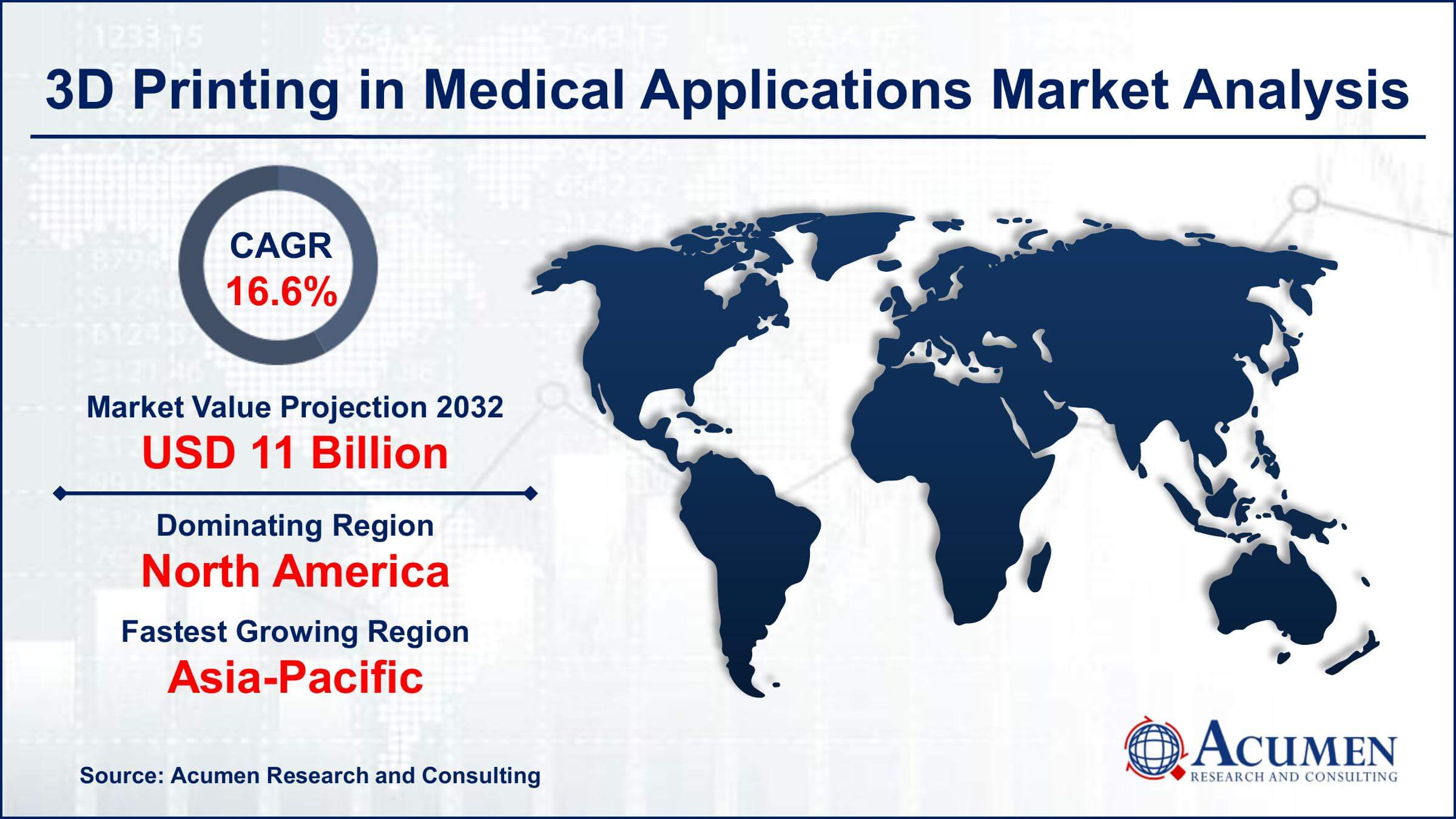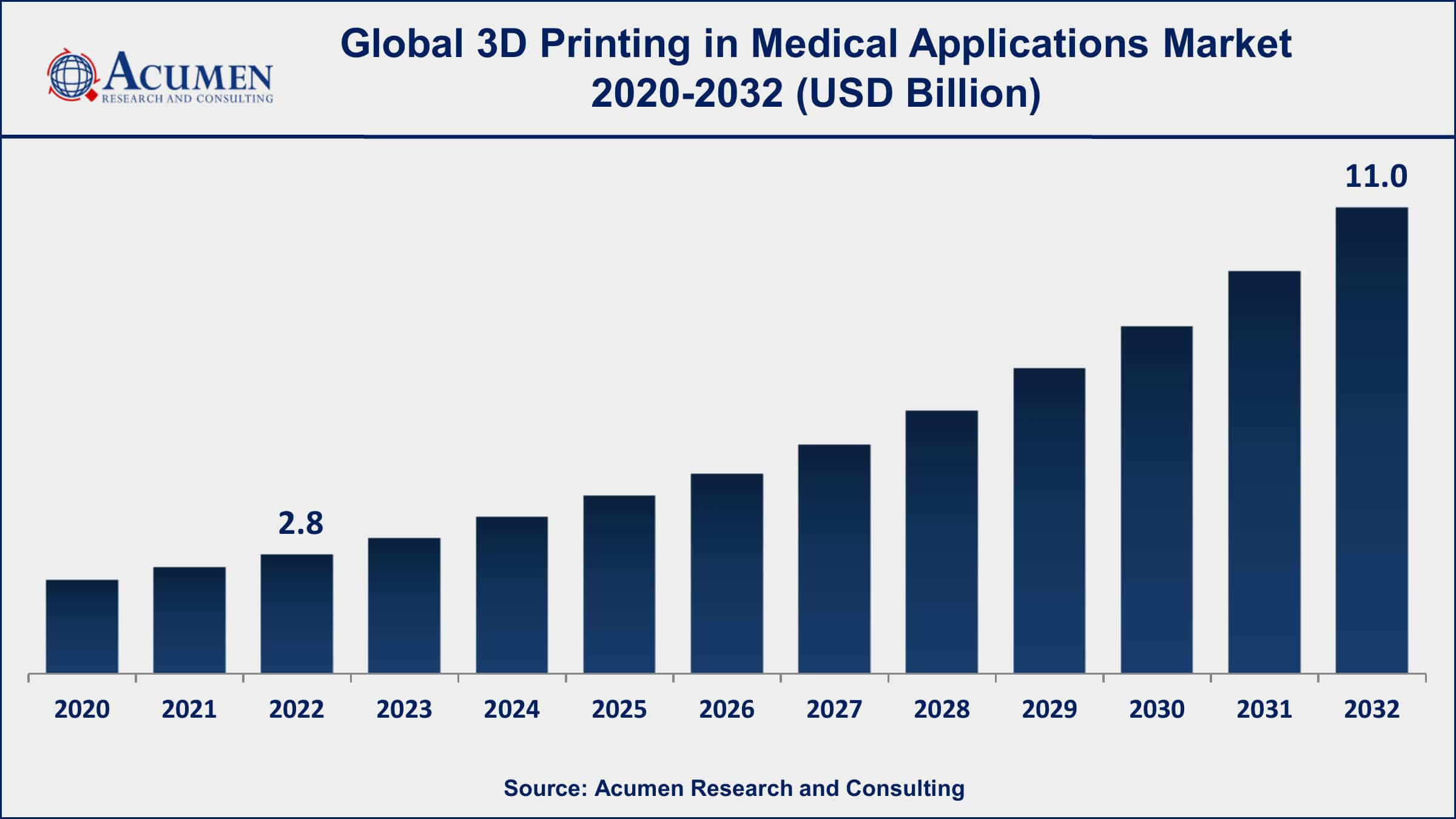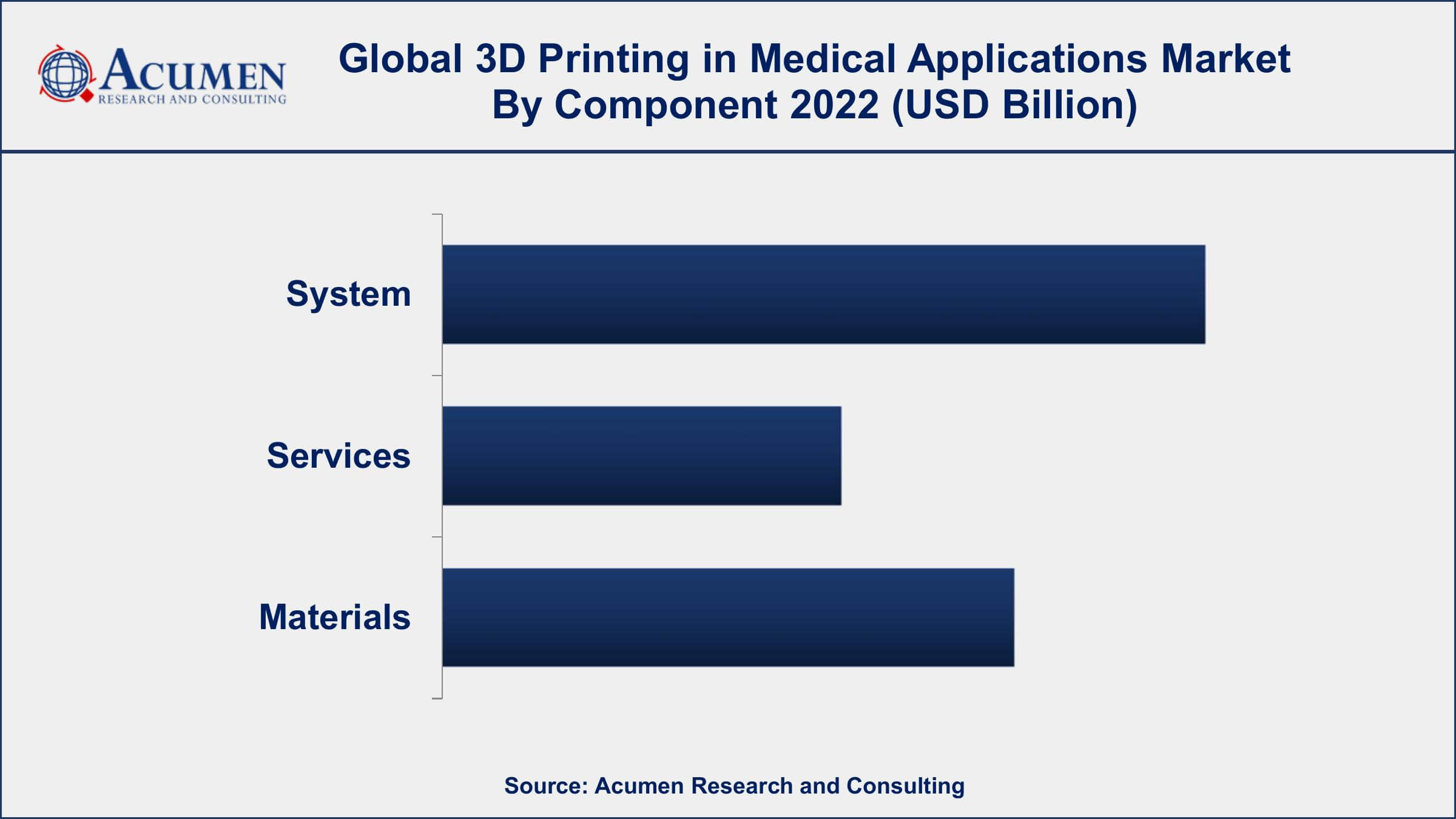3d Printing In Medical Applications Market | Acumen Research and Consulting
3D Printing in Medical Applications Market Size - Global Industry, Share, Analysis, Trends and Forecast 2023 - 2032
Published :
Report ID:
Pages :
Format :
The Global 3D Printing in Medical Applications Market Size accounted for USD 2.8 Billion in 2022 and is projected to achieve a market size of USD 11 Billion by 2032 growing at a CAGR of 16.6% from 2023 to 2032.
3D Printing in Medical Applications Market Report Key Highlights
- Global 3D printing in medical applications market revenue is expected to increase by USD 11 Billion by 2032, with a 16.6% CAGR from 2023 to 2032
- North America region led with more than 42% of 3D printing in medical applications market share in 2022
- The dental industry accounts for around 35% of the market share for 3D printing in the healthcare sector
- According to a study published in the Journal of Surgical Oncology, using 3D printing in surgical planning can save surgical time by an average of 25% and surgical costs by 30%
- In 2022, the medical implants segment held the largest market share.
- The polymer segment is the most important material segment in the 3D printing market for medical applications
- The droplet deposition technology segment of the market is expected to grow at the highest CAGR during the forecast period
- Rising demand for customized medical solutions, drives the 3D printing in medical applications market size

3D printing, also known as additive manufacturing, is a process of creating three-dimensional objects by layering materials on top of each other. In medical applications, 3D printing is used to create custom implants, prosthetics, surgical tools, and even human tissues and organs. One of the significant advantages of 3D printing in medicine is its ability to create patient-specific solutions that are tailored to the individual's unique anatomy. This technology has been used to create customized implants for bone and joint replacements, dental prosthetics, and even hearing aids.
In recent years, 3D printing has also been used to create replicas of human organs for surgical planning and simulation. This technology is particularly useful for complex surgeries where a surgeon can practice and plan the procedure ahead of time on a replica of the patient's organ. The market for 3D printing in the medical field is expected to continue to grow significantly in the coming years. The increasing prevalence of chronic diseases and injuries, advancements in 3D printing technology, and growing demand for personalized medical solutions are some of the factors driving the growth of 3D printing in healthcare market.

Global 3D Printing in Medical Applications Market Trends
Market Drivers
- Advancements in 3D printing technology
- Growing demand for organ transplants
- Increasing Prevalence of Chronic Diseases and Injuries
- Rising Demand for Customized Medical Solutions
Market Restraints
- High costs of 3D printing equipment and materials
- Lack of skilled professionals
Market Opportunities
- Reduced Costs and Improved Efficiency
- Emerging application in multiple procedures
3D Printing in Medical Applications Market Report Coverage
| Market | 3D Printing in Medical Applications Market |
| 3D Printing in Medical Applications Market Size 2022 | USD 2.8 Billion |
| 3D Printing in Medical Applications Market Forecast 2032 | USD 11 Billion |
| 3D Printing in Medical Applications Market CAGR During 2023 - 2032 | 16.6% |
| 3D Printing in Medical Applications Market Analysis Period | 2020 - 2032 |
| 3D Printing in Medical Applications Market Base Year | 2022 |
| 3D Printing in Medical Applications Market Forecast Data | 2023 - 2032 |
| Segments Covered | By Component, By Application, By Technology, By End User, And By Geography |
| Regional Scope | North America, Europe, Asia Pacific, Latin America, and Middle East & Africa |
| Key Companies Profiled | Stratasys Ltd, Formlabs Inc., Organovo Holdings, Inc., 3D Systems Corporation, Oxferd Performance Materials, Inc., Materialise NV, SLM Solutions Group AG, Exone Company, Proto Labs, and General Electric. |
| Report Coverage |
Market Trends, Drivers, Restraints, Competitive Analysis, Player Profiling, Covid-19 Analysis, Regulation Analysis |
3D printing or three-dimensional printing or additive manufacturing (AM) is a process used to synthesize a 3D or three-dimensional object. In this process, successive material layers are formed underneath the control of the computer in order to develop a three-dimensional object. Such objects are manufactured with almost any geometry or shape and are created based on available digital 3D model data. There are various existing and upcoming applications of 3D printing. Some of these applications include medical, industrial, film, advertisements, and stationery. Conventional production techniques rely on the subtractive method in which, the desired products are developed by drilling or cutting the base material. In the 3D printing process, the desired products are built with layer-by-layer addition of materials. Thus, this process is also known as additive manufacturing. Although 3D printing is a type of additive manufacturing, the word is used synonymously for additive manufacturing in the global industry.
Growing requirements for a number of technological advancements in the medical sector have supplemented the growth of the 3D printing medical devices market. 3D printing technology has helped the medical industry to solve plenty of issues. This technology has transformed the healthcare industry by delivering a number of 3D-printed products such as surgical guides, surgical instruments, medical implants, and bioengineered products. Applications of 3D printing in the medical industry are likely to grow at a noteworthy rate over the entire forecast period. This is mainly attributed to an upturn in the need for inexpensive and quick resolutions for medical problems. Furthermore, growing investments in research and development of new innovative 3D printing technologies will also drive the 3D printing market in medical applications. However, the lack of skilled professionals and the unavailability of raw materials may hinder the demand for 3D printing technology in medical applications.
Three-dimensional or 3D printing technologies assist medical researchers in manufacturing implants and medical surgical guides like orthopedic, dental, and Cranio-Maxillofacial. Also, 3D-printed articles improve the overall efficiency of surgical apparatus by producing self-sterilizing medical surgical instruments. The production of such bio-models is completed by using different raw materials such as polymers, metals biological cells, and ceramics. Such raw materials, when utilized with 3D printing methods such as laser beam melting (LBM), droplet deposition manufacturing (DDM), electron beam melting (EBM), and photopolymerization result in the production of different bio-models.
Since its inception, 3D printing technology has evolved and revolutionized its production process year by year. Ever-growing cost pressures for manufacturing medical device and the significant need to offer innovative products has pushed manufacturers to implement 3D printing as a way to decrease the production life cycle and near to eliminate the conventional prototyping process completely.
3D Printing in Medical Applications Market Segmentation
The global 3D printing in medical applications market segmentation is based on component, application, technology, end user, and geography.
3D Printing in Medical Applications Market By Component
- System
- Services
- Materials
- Metals & Alloys
- Polymers
- Thermoplastics
- Photopolymers
- Ceramics
- Others

According to the 3D printing in medical applications industry analysis, the system segment accounted for the largest market share in 2022. The system segment refers to the hardware and software used for 3D printing. The 3D printing system segment includes printers, software, and materials. 3D printers used in the medical industry are typically classified based on the technology used, such as Fused Deposition Modeling (FDM), Stereolithography (SLA), and Selective Laser Sintering (SLS). Each technology has its own strengths and weaknesses, and the choice of printer technology depends on the specific application and material used.
3D Printing in Medical Applications Market By Application
- External Wearable Devices
- Prosthesis & Orthotics
- Hearing Aids
- Dental Products
- Implants
- Surgical Guides
- Orthopedic Implants
- Cranio-maxillofacial Implants
- Clinical Study Devices
- Anatomical Models
- Drug Testing
- Tissue Engineering
In terms of application, the external wearable devices segment has seen significant growth in the coming years. External wearable devices refer to medical devices that are worn on the outside of the body, such as prosthetics, braces, and orthotics. One of the key benefits of 3D printing in the external wearable devices segment is the ability to create custom-fitted devices that are tailored to the specific needs and anatomy of each patient. Traditionally, external wearable devices were produced using manual manufacturing processes, which often required multiple adjustments and fittings to achieve a proper fit. With 3D printing, medical professionals can create precise models of the patient's anatomy and use these models to create custom-fitted devices that are more comfortable and effective.
3D Printing in Medical Applications Market By Technology
- Droplet Deposition
- Low-temperature Deposition Manufacturing (LDM)
- Fused Filament Fabrication (FFF) Technology
- Multiphase Jet Solidification (MJS)
- Laser Beam Melting
- Direct Metal Laser Sintering (DMLS)
- Selective Laser Melting (SLM)
- Selective Laser Sintering (SLS)
- Photopolymerization
- Two-photon Polymerization (2PP)
- Continuous Liquid Interface Production (CLIP)
- Stereolithography (SLA)
- Laminated Object Manufacturing
- Electronic Beam Melting (EBM)
- Others
- MultiJet Printing
- Color Jet Printing
According to the 3D printing in medical applications market forecast, the droplet deposition segment is expected to continue to grow in the coming years. Droplet deposition refers to a 3D printing process that uses inkjet or aerosol printing technology to deposit small droplets of material onto a surface to build up a three-dimensional structure. Droplet deposition has several advantages in the medical industry. It is a highly precise and accurate method of printing, which is important for medical applications that require high levels of accuracy and reproducibility. The technology is also compatible with a wide range of materials, including biocompatible and biodegradable materials, which are often used in medical applications.
3D Printing in Medical Applications Market By End User
- Medical & Surgical Centers
- Academic Institutions
- Pharmaceutical & Biotechnology Companies
In terms of end users, the medical and surgical centers segment is leading the market in 2022. This segment includes a wide range of applications, including surgical planning and simulation, the production of anatomical models, and the creation of custom implants and prosthetics. One of the key benefits of 3D printing in medical and surgical centers is the ability to create highly customized medical devices and implants that are tailored to the specific needs of each patient. This includes implants and prosthetics that are designed to fit a patient's unique anatomy, as well as surgical tools and guides that are customized to a specific surgical procedure. In addition to customization, 3D printing also enables medical professionals to produce highly accurate and detailed anatomical models that can be used for surgical planning and simulation. These models allow surgeons to better understand the patient's anatomy and plan their surgical approach more effectively, which can improve surgical outcomes and reduce the risk of complications.
3D Printing in Medical Applications Market Regional Outlook
North America
- U.S.
- Canada
Europe
- U.K.
- Germany
- France
- Spain
- Rest of Europe
Asia-Pacific
- India
- Japan
- China
- Australia
- South Korea
- Rest of Asia-Pacific
Latin America
- Brazil
- Mexico
- Rest of Latin America
The Middle East & Africa
- South Africa
- GCC Countries
- Rest of the Middle East & Africa (ME&A)

3D Printing in Medical Applications Market Regional Analysis
North America is currently dominating 3D printing in the medical applications market for several reasons. One of the primary reasons is the high level of investment in research and development of 3D printing technology in the region. Many leading 3D printing companies, such as Stratasys, 3D Systems, and Materialise, are based in North America, which has helped to drive innovation and development in the industry.
In addition, the healthcare industry in North America is highly advanced and well-funded, with a focus on adopting innovative technologies to improve patient outcomes. This has led to a growing demand for 3D printing in medical applications, as medical professionals seek to improve the precision and accuracy of medical devices and surgical procedures. North America has a large and established healthcare infrastructure that is well-positioned to adopt and integrate 3D printing technology in patient care.
3D Printing in Medical Applications Market Player
Some of the top 3D printing in medical applications market companies offered in the professional report include Stratasys Ltd, Formlabs Inc., Organovo Holdings, Inc., 3D Systems Corporation, Oxferd Performance Materials, Inc., Materialise NV, SLM Solutions Group AG, Exone Company, Proto Labs, and General Electric.
Frequently Asked Questions
What was the market size of the global 3D printing in medical applications in 2022?
The market size of 3D printing in medical applications was USD 2.8 Billion in 2022.
What is the CAGR of the global 3D printing in medical applications market during forecast period of 2023 to 2032?
The CAGR of 3D printing in medical applications market is 16.6% during the analysis period of 2023 to 2032.
Which are the key players operating in the market?
The key players operating in the global 3D printing in medical applications market are Stratasys Ltd, Formlabs Inc., Organovo Holdings, Inc., 3D Systems Corporation, Oxferd Performance Materials, Inc., Materialise NV, SLM Solutions Group AG, Exone Company, Proto Labs, and General Electric.
Which region held the dominating position in the global 3D printing in medical applications market?
North America held the dominating position in 3D printing in medical applications market during the analysis period of 2023 to 2032.
Which region registered the fastest growing CAGR for the forecast period of 2023 to 2032?
Asia-Pacific region exhibited fastest growing CAGR for 3D printing in medical applications market during the analysis period of 2023 to 2032.
What are the current trends and dynamics in the global 3D printing in medical applications market?
The current trends and dynamics in the 3D printing in medical applications industry include the advancements in 3D printing technology, and increasing prevalence of chronic diseases and injuries.
Which component held the maximum share in 2022?
The system component held the maximum share of the 3D printing in medical applications market.



